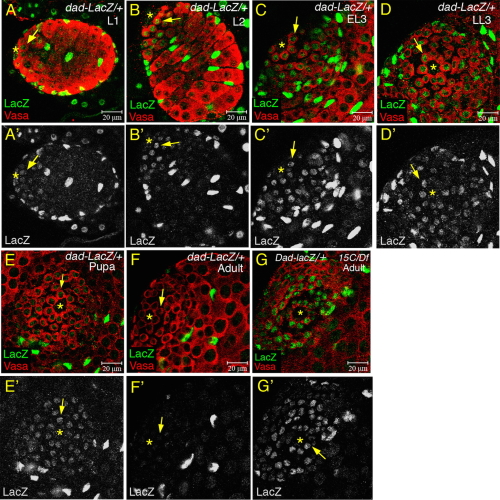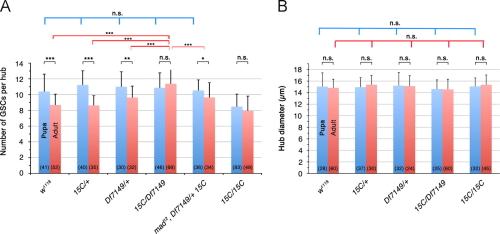Project Description
Dev Biol. 2013 Nov 1;383(1):106-20. doi: 10.1016/j.ydbio.2013.08.014. Epub 2013 Aug 26.
Smurf-mediated differential proteolysis generates dynamic BMP signaling in germline stem cells during Drosophila testis development

Author information
Yi-Jie Chang,1,2,5, Haiwei Pi,1,2,4,5, Chang-Che Hsieh,1,2, Margaret T. Fuller3
- Graduate Institute of Biomedical Sciences, College of Medicine, Chang Gung University, 259 Wen-Hwa 1st Road, Kwei-Shan, Tao-Yuan 333, Taiwan
- Department of Biomedical Sciences, College of Medicine, Chang Gung University, 259 Wen-Hwa 1st Road, Kwei-Shan, Tao-Yuan 333, Taiwan
- Department of Developmental Biology, Stanford University, School of Medicine, Stanford, CA 94305, USA
- Corresponding author at: Department of Biomedical Sciences, College of Medicine, Chang Gung University, 259 Wen-Hwa 1st Road, Kwei-Shan, Tao-Yuan 333, Taiwan.
- These two authors contribute equally to this work.
論文介紹
 成體幹細胞位於一個特殊的微環境(niche)。在這個微環境內,幹細胞接收特定訊號來進行自我更新以維持幹細胞的數目及功能。
成體幹細胞位於一個特殊的微環境(niche)。在這個微環境內,幹細胞接收特定訊號來進行自我更新以維持幹細胞的數目及功能。
對於果蠅配子幹細胞,最重要的自我更新訊號是 BMP 訊息。在雄性成體性腺中,低強度但是持續的 BMP 訊息路徑活性對於配子幹細胞的自我更新是很重要的。
在這篇文章中,我們最主要的是發現是在發育過程中,配子幹細胞內的 BMP 訊息路徑活性是由強變弱。而這個轉變只發生在特定的時間點,也就是從幼蟲三齡早期到三齡晚期的時候。我們也發現 smurf ,一種蛋白質降解促進蛋白(ubiquitous E3 ligase),對這個由強變弱的轉變是非常重要的 。在 smurf 突變中, 配子幹細胞內的 BMP 訊息路徑強度在所有的發育時期都變得很高。因此,Smurf 是限制配子幹細胞內 BMP 訊息路徑強度的重要因子。
在接下來的實驗裡,我們也證明 smurf 對於配子幹細胞的數目及精原細胞(配子幹細胞的分化子細胞)的分裂次數是非常重要的。在 smurf 的突變性腺中,幹細胞和精原細胞的數目都會增加,導致器官大小產生變化。
有趣的是 ,smurf 在配子幹細胞內的表達在不同的時期都沒有變化,代表 BMP 訊息路徑活性由強轉弱的轉變並不是因為 smurf 表達變強的緣故。最後我們發現在發育中的不同時期定量表達 smurf,BMP 訊息路徑活性在發育晚期的配子幹細胞內仍然變弱,顯示 smurf 蛋白活性在晚期配子幹細胞內可能是被加強的。因此,我們的研究發現,在發育過程中,配子幹細胞內有一個內生性的機制來調節自我更新訊號的強度。
Abstract
Germline stem cells (GSCs) produce gametes throughout the reproductive life of many animals, and intensive studies have revealed critical roles of BMP signaling to maintain GSC self-renewal in Drospophila adult gonads. Here, we show that BMP signaling is downregulated as testes develop and this regulation controls testis growth, stem cell number, and the number of spermatogonia divisions. Phosphorylated Mad (pMad), the activated Drosophila Smad in germ cells, was restricted from anterior germ cells to GSCs and hub-proximal cells during early larval development. pMad levels in GSCs were then dramatically downregulated from early third larval instar (L3) to late L3, and maintained at low levels in pupal and adult GSCs. The spatial restriction and temporal down-regulation of pMad, reflecting the germ cell response to BMP signaling activity, required action in germ cells of E3 ligase activity of HECT domain protein Smurf. Analyses of Smurf mutant testes and dosage-dependent genetic interaction between Smurf and mad indicated that pMad down-regulation was required for both the normal decrease in stem cell number during testis maturation in the pupal stage, and for normal limit of four rounds of spermatogonia cell division for control of germ cell numbers and testis size. Smurf protein was expressed at a constant low level in GSCs and spermatogonia during development. Rescue experiments showed that expression of exogenous Smurf protein in early germ cells promoted pMad downregulation in GSCs in a stage-dependent but concentration-independent manner, suggesting that the competence of Smurf to attenuate response to BMP signaling may be regulated during development. Taken together, our work reveals a critical role for differential attenuation of the response to BMP signaling in GSCs and early germ cells for control of germ cell number and gonad growth during development.







